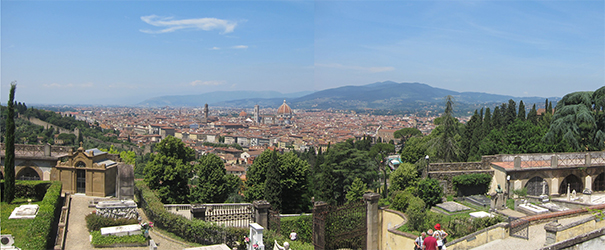
ARTH Home | ARTH Courses | ARTH 213 Assignments | Contact
ARTH 213 Syllabus
History of Italian Renaissance Art
Spring, 2014
Tuesday, 5:30- 8:00; FAC 166.
Dr. Allen Farber, Associate
Professor
303 Fine Arts Center (436- 2558); E-Mail: FARBERAS@oneonta.edu.
Office Hours: Tuesday and Thursday 10:00-11:00, Wednesday 1:00-3:00, or by appointment. Notes can be left in my mailbox in 222 FAC, or messages can be left through Voice-Mail at 6-2558. I would also encourage you to communicate with me over E-Mail.
Course Web Page: www.oneonta.edu/faculty/farberas/arth/Arth213/ARTH213_Syllabus.html
Purposes of the Course:
1) To acquaint you with
the major monuments of the art of the Italian Renaissance.
2) To acquaint you with the variety of ways scholars have approached the art
of this period, and to give you the opportunity to read, think, and write critically
about art and art history.
Course Format:
1) This course will be conducted in a lecture/discussion format. I would like to encourage as much active participation in the class as possible.
This semester I have decided to change the structure of this course. In the past I have approached this course from a traditional structure focusing on the chronological "development" of Italian Renaissance art with special attention given to hightlighting the contributions of the major artists. This approach is one that has been inherited from Giorgio Vasari who in the sixteenth century wrote a collection of artist's biographies entitled Lives of the Artists. Many of the textbooks devoted to the period follow this chronological approach with the artists of the Fourteenth Century or Trecento being seen as "Precursors of the Renaissance", the Fifteenth Century or Quattrocento labeled as the Early Renaissance, and the Sixteenth Century or Cinquecento being understood as a period of maturity beginning with the High Renaissance.
Instead of this traditional structure, I want to experiment with a thematic approach. Jacob Burckhardt a Swiss scholar published in 1860 his Civilization of the Italian Renaissance. Laid out in this text are themes that have dominated Renaissance studies until the present. The book is layed out in six parts. I want to use three of these parts as the focus of this course: "The Development of the Individual," "The Discovery of the World and Man," and "Revival of Antiquity." This different approach will allow me to introduce more recent critical approaches into our discussions. At the end of this syllabus I have outlined a tentative list of topics. I have to emphasize the tentative nature of this listing since I am still experimenting with this structure.
2) The World Wide Web presents us with a phenomenal resource to study art. Images and other materials can be made immediately accessible to students. I intend to take advantage of this resource. I will be posting materials relevant to the course on this course's Web site. I plan to post material to help you prepare for class discussions and seminars. To keep up to date, check the page entitled "ARTH 213 Assignments."
http://employees.oneonta.edu/farberas/arth/Arth213/ARTH213_Assignments.html
3) I will evaluate your performance in this course on the basis of three short papers. Two of these papers will be seminar reports. These will be in response to two seminars we will hold during the course of the semester. The first of these seminars will be devoted to the revolution in sculpture evident in the art of Donatello, Ghiberti, Brunelleschi, and Nanni di Banco at the beginning of the fifteenth century, and the second will focus on Raphael's Stanza della Segnatura and the Renaissance concept of knowledge. Before these seminars you will be given materials to prepare you for the discussions. The week after the completion of the seminar you will be expected to submit a three - five page paper presenting your response to the discussion. You will be expected to focus on an aspect of the topic.
The third paper will be on a topic of your own choice. Your paper can be a traditional visual analysis of a work of Italian Renaissance art, preferably one that you can study directly, or you can pick a more general problem. Your topics do not need to be restricted to the confines of art history. For example. I would accept a paper studying the status of women in Renaissance society. You must have your topic approved by me. If not your paper will not be accepted. This third paper will be due the last day of classes.
Text:
The text for this course is John T. Paoletti and Gary M. Radke, Art in Renaissance Italy (4th edition)
Tentative Schedule of Classes:
Jan. 21: Introductory Class: Bill Moyers' video entitled The Power of the Past.
Jan. 28: Historical, Social, Economic, and Artistic Contexts for Italian Renaissance Art -Paoletti and Radke, pp. 12-45.
"The Development of the Individual"
Feb. 4: Read excerpts of John Martin, "Inventing Sincerity, Refashioning Prudence: the Discovery of the Individual in Renaissance Europe."
"God Becomes Man": The Art of Giotto. Paoletti and Radke, pp. 48-55, 72-98.
Feb. 11: "Civic Humanism": Early Fifteenth Century Florentine Sculpture (First Seminar). Paoletti and Radke, pp. 201-215.
Feb. 25: "Competing Identities": Variety in Early Fifteenth Century Florentine Painting. Paoletti and Radke, pp. 219-235.
March 4: "Constructing Power": Art and the Private and Public Patronage of Renaissance Princes. Paoletti and Radke, 249-279
March 11: "Man Becomes a God": "The Divine" Michelangelo. Paoletti and Radke, pp. 385-392; 396-409.
March 25: The Mona Lisa and her sisters: Images of Women in Fifteenth and Early Sixteenth Century Art. Paoletti and Radke , pp. 276-277; 392-394.
Revival of Antiquity:
April 8: Different Approaches to Antiquity: Botticelli's Mythologies and the art of Mantegna. Paoletti and Radke, pp. 279-285; 354-361.
Discovery of the World and Man:
April 15: Putting the World Into Perspective.
April 22: Measure and Order in Renaissance Architecture.
April 29: Renaissance Concepts of Knowledge and Raphael's Stanza della Segnatura. Paoletti and Radke, pp. 409-417.
May 6: Putting God into Perspective.